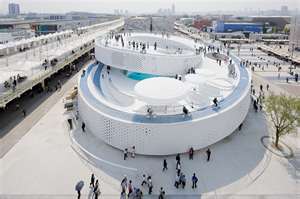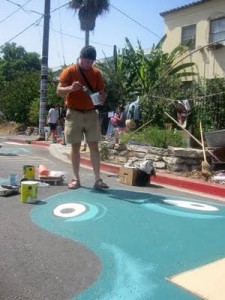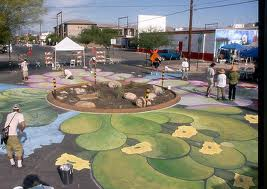Bjarke Ingels: Sustainable Architecture Evolution
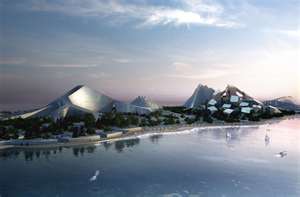 Bjarke Ingels is founder of the Danish sustainable architect group BIG out of Copenhagen. His creations are not typical 2 dimensional architect designs but rather futuristic designs like something found in Hollywood. In fact, Hollywood has even copied his designs, something Bjarke considers a compliment. Bjarke’s construction integrates ecosystems that channel heat, energy, water and waste into the natural environment. His approach to building is to improve the quality of life for sustainable communities. One of his buildings is called the 8 House named after its figure 8 shape. This building lifts the town homes above the shops on the street creating views and gardens while also inviting the public up into the many different and beautiful levels above.
Bjarke Ingels is founder of the Danish sustainable architect group BIG out of Copenhagen. His creations are not typical 2 dimensional architect designs but rather futuristic designs like something found in Hollywood. In fact, Hollywood has even copied his designs, something Bjarke considers a compliment. Bjarke’s construction integrates ecosystems that channel heat, energy, water and waste into the natural environment. His approach to building is to improve the quality of life for sustainable communities. One of his buildings is called the 8 House named after its figure 8 shape. This building lifts the town homes above the shops on the street creating views and gardens while also inviting the public up into the many different and beautiful levels above.
Another one of Bjarke’s plans is a proposed 3-mile bridge across the water to Sweden connecting a binational metropolitan region. This will have a train line going between the cities and combines alternative energy from both countries. Excess engergy from power production becomes usable energy for all. Why Copenhagen? Just compare these statistics on renewable energy and waste: In Copenhagen only 4% of waste actually goes to landfills versus Chicago where 85% of waste goes to landfills. Now imagine waste being turned into energy! Thats exactly what Copenhagen does, 42% gets recycled and 54% is used as fuel to create heat and electricity. For every 3kg of trash you get in return 4 hrs of electricity and 5 hrs of heat!
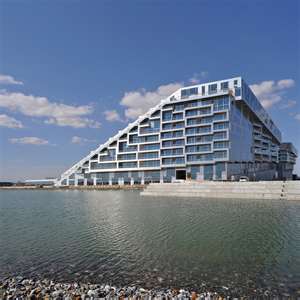 And there is a recreational aspect to Bjarke’s sustainability too. The people in Copenhagen love to ski and get plenty of snow but unfortunately their land is flat. To solve this Bjarke has designed a rooftop for the power factory where the waste is incinerated and turned into energy. This rooftop acts as a ski slope in both summer and winter time. Accessed by the elevator up to the roof where a carpet like material collects rain and snow creating a ski surface for ski and snow boarding back down to the street. Amazing! The smoke stack also compresses CO2 and produces non toxic smoke rings and sends them up into the sky. This is what we call a sustainable architecture evolution!
And there is a recreational aspect to Bjarke’s sustainability too. The people in Copenhagen love to ski and get plenty of snow but unfortunately their land is flat. To solve this Bjarke has designed a rooftop for the power factory where the waste is incinerated and turned into energy. This rooftop acts as a ski slope in both summer and winter time. Accessed by the elevator up to the roof where a carpet like material collects rain and snow creating a ski surface for ski and snow boarding back down to the street. Amazing! The smoke stack also compresses CO2 and produces non toxic smoke rings and sends them up into the sky. This is what we call a sustainable architecture evolution!
Key Elements to Bjarke Ingels Architecture Designs are:
● Designs that increase the quality of life in the communities
● Integrate energy, water and beauty into construction design
● Designs with minimal waste by building leftovers into contruction
● Designs that invite the public into its beautiful spaces
● Designs that create a healthy and enjoyable environment
Life in a Day the Film
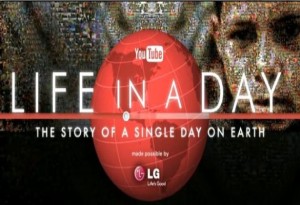 Life in a Day is a gift; a once in a lifetime opportunity to see life from hundreds of different perspectives across the globe. Life in a Day shows the daily life of people from 192 countries as they wake up and live their lives on one day, July 24, 2010. For the first time we see what it’s like to wake up somewhere different, what it’s like to eat, work, laugh, love, live, have friendship, romance and fun. There are so many differences, yet at the heart of it, we all laugh, cry, love, eat, sleep, have friends, family and loved ones. Surprisingly, much of the day to day activities and work is similar and you’ll be surprised how you naturally empathize and feel for the people and animals in the film.
Life in a Day is a gift; a once in a lifetime opportunity to see life from hundreds of different perspectives across the globe. Life in a Day shows the daily life of people from 192 countries as they wake up and live their lives on one day, July 24, 2010. For the first time we see what it’s like to wake up somewhere different, what it’s like to eat, work, laugh, love, live, have friendship, romance and fun. There are so many differences, yet at the heart of it, we all laugh, cry, love, eat, sleep, have friends, family and loved ones. Surprisingly, much of the day to day activities and work is similar and you’ll be surprised how you naturally empathize and feel for the people and animals in the film.
Good and bad, this film will show you things that are really happening in your world, whether you like it or not. You will be surprised by what unites us and divides us. Laugh, cry, cringe, smile, rejoice; all of these things I did while watching. I know this will stir some emotion in you. Perhaps you will never be the same again. I know I won’t be. Here’s Life in a Day.
Permaculture: Saving Humanity and the Earth
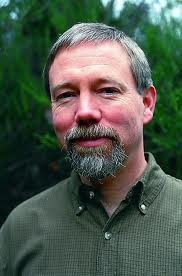 Toby Hemenway is a teacher, consultant and lecturer on permaculture and ecological design. Toby is also a professor at Portland State University, a Scholar-in-Residence at Pacific University, and a biologist consultant for the Biomimicry Guild. In this lecture Toby explains how Agriculture has not actually helped mankind but instead has hindered our progress as well as causing a negative impact on our Earth. Agriculture destroys our eco system by wiping away the lusciousness of our land and forests by depleting nutrients and destroying the topsoil by over growing huge amounts of food in designated areas. The land then requires massive amounts of fertilizer which now comes mainly from petroleum based products.
Toby Hemenway is a teacher, consultant and lecturer on permaculture and ecological design. Toby is also a professor at Portland State University, a Scholar-in-Residence at Pacific University, and a biologist consultant for the Biomimicry Guild. In this lecture Toby explains how Agriculture has not actually helped mankind but instead has hindered our progress as well as causing a negative impact on our Earth. Agriculture destroys our eco system by wiping away the lusciousness of our land and forests by depleting nutrients and destroying the topsoil by over growing huge amounts of food in designated areas. The land then requires massive amounts of fertilizer which now comes mainly from petroleum based products.
Hemenway shows that since the introduction of agriculture the human life span has decreased while degenerative diseases and even famines have increased. People are just less healthy than pre agriculture time. Since the introduction of agriculture eating cooked foods has increased causing babies to be weaned from their mothers sooner which allows them to become pregnant again sooner since they are no longer nursing. This explains the higher population in agriculture times that requires even more food to be grown to feed them all.
Toby says the Solution to the problems caused by agriculture is Permaculture, which is horticulture. Permaculture creates a horticultural society which is sustainable. This means small-scale gardens of mixed crops not farms, and hoes versus plows. While agriculture destroys land and cuts back forests, horticulture and permaculture encourages ecosystems to function. They require a lot less labor, encourage wildlife to thrive, and Toby has also noticed a more spiritual approach that honors the Earth with horticulture versus conventional agriculture that, from the Earth’s perspective, could be characterized as a much more “greedy” approach.
Toby’s Key Permaculture Advantages over Agriculture:
● Permaculture encourages ecosystems to function and supports the health of land and forests
● Permaculture decreases degenerative diseases and epidemics
● Human Lifespan decreases when going from Permaculture to Agriculture
● Agriculture requires much more labor than Permaculture
● “Agriculture will destroy humanity while Permaculture will save it”
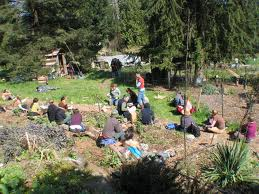 Toby believes that if we keep doing what we have been doing we dont have even a century left before we destroy ourselves. Horticulturists on the other hand have a long track record and can be sustainable. Permaculture works with nature not against it and even turns waste into beautiful gardens. Toby ends the talk by giving examples of many horticultural tribes that lived and prospered for thousands of years before being wiped out by agriculture.
Toby believes that if we keep doing what we have been doing we dont have even a century left before we destroy ourselves. Horticulturists on the other hand have a long track record and can be sustainable. Permaculture works with nature not against it and even turns waste into beautiful gardens. Toby ends the talk by giving examples of many horticultural tribes that lived and prospered for thousands of years before being wiped out by agriculture.
Barefoot College: Solar Technology to the Poor
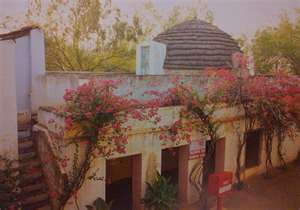 Bunker Roy grew up in Inda with the most expensive elitist education. After graduating in 1965 he told his mother he wanted to go work with the poor and see what a village was like. This disapointed her and she felt he had let the family down. He decided to open a college for the poor in which no PhD’s or privileged were accepted. There would be no contracts, degrees or certificates. In 1986 the Barefoot College was built… built by the poor who had no education, for the poor. The Barefoot College also became the first solar powered college in India, operating a solar system installed by a Hindu Priest who had only 8 years of primary schooling and no college who Bunker says “knows more about solar than anybody.”
Bunker Roy grew up in Inda with the most expensive elitist education. After graduating in 1965 he told his mother he wanted to go work with the poor and see what a village was like. This disapointed her and she felt he had let the family down. He decided to open a college for the poor in which no PhD’s or privileged were accepted. There would be no contracts, degrees or certificates. In 1986 the Barefoot College was built… built by the poor who had no education, for the poor. The Barefoot College also became the first solar powered college in India, operating a solar system installed by a Hindu Priest who had only 8 years of primary schooling and no college who Bunker says “knows more about solar than anybody.”
All food at this solar school was cooked with a solar cooker fabricated by the women. The dentist at the college is a grandmother who looks after 7000 children. All the roofs at the Barefoot College catch the rain and connect to a 400,000 liter tank providing all their fresh water. Children who have chores during the day come to school at night, and as the students here became trained in solar energy, solar villages started popping up all over India. Soon they went to Afghanistan to train 3 Afghani women in solar technology who then taught 27 women who solarized 100 villages.
Bunker jokes about woment being easier to train then men.
Bunker Roy later sent women to Africa to teach solar power technology to African women. These women then trained others in solar energy throughout Gambia. Bunker says we need to look for solutions within the people of communities rather than from the world banks. He ends with a quote from Ghandi: “First they ignore you, then they laugh at you, then they fight with you, then… you win!”
Key Principles at the Barefoot College: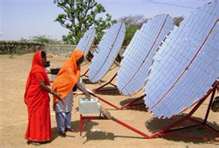
● Look for Solutions from within the Community
● Educate People Eager to Learn Regardless of their Status
● Degrees mean Nothing compared to Hands on Training
● Give the Underpriveledged a Chance and They will Change the World
Urban Permaculture for Communities: Re-patterning the Grid
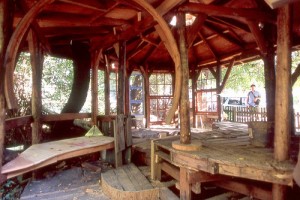 Visionary and eco-architect Mark Lakeman is founder of City Repair, Communitecture Architects, and the Planet Repair Institute. Mark goes against the traditional architecture teachings that humanity and nature are separate. Instead he brings these two concepts together, expressing them in beautiful artform. Modeling the plazas of Mexico and South America, Mark is teaching people the foundations of community by showing them the value of building open spaces to sit and gather, gardens, and places to read and drink tea. The end result is creative and beautiful.
Visionary and eco-architect Mark Lakeman is founder of City Repair, Communitecture Architects, and the Planet Repair Institute. Mark goes against the traditional architecture teachings that humanity and nature are separate. Instead he brings these two concepts together, expressing them in beautiful artform. Modeling the plazas of Mexico and South America, Mark is teaching people the foundations of community by showing them the value of building open spaces to sit and gather, gardens, and places to read and drink tea. The end result is creative and beautiful.
Unlike modern architecture designed with a T-square and triangle, Mark designs in relation to the natural landscapes and natural curves and spaces in the community. He also designs according to the wants and needs of the people in the community.
One unique example in this video of designing for the specific wants and needs of the community is the first solar cat palace featuring a built in aquarium for the cats to paw and look at through the glass, passive solar allowing the sun to shine deep inside providing warmth during the colder months, and a solar skylight. End result: the cats and community love it!
Urban Permaculture utilizes the following building concepts:
● Designs according to the natural landscapes of the neighborhood
● Designed with open spaces to gather, sit, read and socialize
● Designed for the wants and needs of the community
● Designed with gardens and art expressing the beauty of the community
● Designed to bring people together rather than to separate and seclude
Urban Permaculture and eco architecture is taking us back in time where communities shared and built together. Back to when neighbors knew each other, helped each other out, and could trust that their children were safe. Mark Lakeman’s city repairing and eco architecture designs are what modern society neighborhoods have been missing for far too long and the results of his work are tearing down the walls of isolationism and bringing people together.
Thank you Mark Lakeman for all you are contributing!! Great video!
Earthship Biotechture: The Food Producing Sustainable Home
 Earthship biotecture was first created by Michael Reynolds from Taos, New Mexico in the 1970’s. This new model of green infrastructure uses recycled tires that are beat full of earth to create thick, solid walls for your home instead of wasting away in landfills. Rainwater is captured for all household use. Water from the sinks and showers (grey water) gets treated by filtering through the inside greenhouse gardens which grow food afterwhich goes to flush the toilets. It then is sent outside to a septic tank.
Earthship biotecture was first created by Michael Reynolds from Taos, New Mexico in the 1970’s. This new model of green infrastructure uses recycled tires that are beat full of earth to create thick, solid walls for your home instead of wasting away in landfills. Rainwater is captured for all household use. Water from the sinks and showers (grey water) gets treated by filtering through the inside greenhouse gardens which grow food afterwhich goes to flush the toilets. It then is sent outside to a septic tank.
Earthships by design to reduce wasted energy and typically stay a comfortable 60 – 75 degrees year around with no additional heating or air conditioning. The south side of the earthship is mostly glass allowing the sun to shine deep into the home in wintertime due to it sitting low in the horizon. This provides winter heat as well as sunshine for the indoor garden. The thick thermal mass walls collect the heat and then release it back into the atmosphere at night. Power is produced by solar panels and stored in batteries for energy when the sun isnt out. An Earthship is an off grid food producing sustainable home.
THE 6 KEY ELEMENTS OF EARTHSHIP BIOTECHTURE ARE: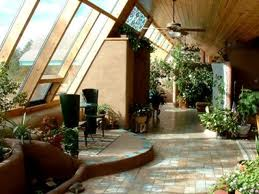
● Generation of Power
● Water Harvesting
● Heating and Cooling without Fuel
● Containing and Treating of Sewage on Site
● In Home Food Production
● Building with Recycled Materials

